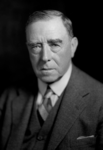The 1931 Victorian local elections were held on 27 August 1931 to elect the councils of 100 of the local government areas in Victoria, Australia. A number of by-elections were also held to fill extraordinary vacancies.[1]
| ||||||||||||||||||||||||||||||||||||||||||||||||||||||||||||||||||||||||||||||||||||||||||||||||||||||||||||||||
| ||||||||||||||||||||||||||||||||||||||||||||||||||||||||||||||||||||||||||||||||||||||||||||||||||||||||||||||||
Until the 1994 reforms introduced by the Kennett state government, all local elections were staggered, with not all councillors up for election each year.[2]
Background edit
Labor went into the local elections with eight sitting councillors, after A. Pollock (Collingwood) and J. Ryan (Port Melbourne) failed to secure party endorsement for re-election. The party ran a total of 19 candidates − 17 in the Greater Melbourne area and two in Wonthaggi.[1]
Before the elections, the federal Nationalist Party merged with a group of defectors from the Labor who supported Joseph Lyons, and formed the United Australia Party. However, the Nationalist name continued to be used for the party's state branch until after the local elections when the name formally changed on 15 September 1931.[3]
A number of local parties contested the elections. Additionally, the All for Australia League contested its first elections, having been formed several months prior in January 1931.[4]
Results edit
| Party | Votes | % | Swing | Seats | Change | ||
|---|---|---|---|---|---|---|---|
| Independents | 119,854 | 79.22 | 150 | ||||
| Labor | 13,234 | 8.75 | 2 | 8 | |||
| Nationalist | 5,829 | 3.85 | 3 | 1 | |||
| Progressive Ratepayers | 3,025 | 2.00 | 4 | 4 | |||
| Port Melbourne Progressives | 2,329 | 1.54 | 2 | 2 | |||
| Returned Soldiers | 1,480 | 0.98 | 1 | 1 | |||
| Reform Movement | 1,431 | 0.95 | +0.95 | 1 | 1 | ||
| Independent Labor | 960 | 0.63 | 0 | ||||
| Preston Progressives | 836 | 0.55 | 1 | 1 | |||
| Unemployed Association | 782 | 0.52 | 0 | ||||
| East Oakleigh Improvement | 386 | 0.26 | 0 | ||||
| Vigilance League | 375 | 0.25 | +0.25 | 0 | |||
| All for Australia | 272 | 0.18 | +0.18 | 0 | |||
| Chelsea Ratepayers | 217 | 0.14 | 0 | ||||
| Country | 135 | 0.09 | 0 | ||||
| Communist | 130 | 0.09 | 0 | ||||
| Total | 151,275 | 100.0 | 165 | ||||
Aftermath edit
Labor suffered losses in Brunswick, Coburg, Collingwood, Footscray, Heidelberg, Port Melbourne and Williamstown.[1]
Four female candidates contested the elections − Ethel Blagdon (Hawthorn), Marie Dalley (Kew), Jennie Baines (Port Melbourne) and Violet Lambert (Fern Tree Gully). Lambert was elected in South Riding, defeating sitting councillor J. Hobbs with 74.04% of the vote.[1]
Notes edit
References edit
- ^ a b c d "MUNICIPAL ELECTIONS". Trove. The Age.
- ^ "FINAL REPORT Electoral Representation Review for the Boroondara City Council (see page 11)" (PDF). Victorian Electoral Commission. 2008-05-26.
- ^ "NATIONALIST PARTY". The Canberra Times. National Library of Australia. 16 September 1931. p. 1.
- ^ Carole Ferrier. "A red revolutionist and ranter". Australian National University. Archived from the original on 28 August 2008.



